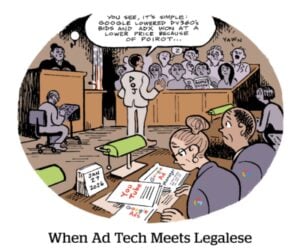Here’s today’s AdExchanger.com news round-up… Want it by email? Sign up here.
Get Connected
The coveted prizes in programmatic right now are exclusive CTV contracts.
In Cannes, the crème de la crème for handshakers and lunch-takers is Netflix. Google is meeting with Netflix there, Ad Age reports, and is an obvious choice as Netflix purportedly looks for an exclusive SSP and/or ad server for when it introduces an ad-supported tier later this year. The other likely options are Comcast’s FreeWheel (Google’s main challenger when it comes to TV and video ad servers) and Magnite, which boasts an exclusive deal with Hulu (though Google has the main Disney CTV SSP contract).
There are nuances to “exclusive” – Google or FreeWheel could win the Netflix ad server contract, with Magnite brought in as an outside SSP partner.
And not every prize needs to be a crown jewel to glimmer.
DIRECTV announced an exclusive deal with Yahoo as the exclusive DSP for its addressable inventory.
In the web world, publishers work with five or six SSPs on average, and rarely name an exclusive vendor. But in TV Land, where there’s deep mistrust of ad tech and where programmers are plagued by frequency capping failures, the supply side prefers to consolidate campaign oversight to one vendor.
All A-Tremor
Tremor would be a long shot to win a Netflix partnership as video ad server or SSP, filling the same indie programmatic role as a Magnite (a handy vendor since Netflix can make practically any client demand and the margin is super compressed because it’s such a lucrative coup for the vendor, which Netflix understands full well).
But Tremor is making noise this week.
For one, Sky News reports Tremor is in talks to buy Amobee, the Singtel-owned DSP. That deal is said to be hovering around $200 million.
Amobee isn’t a major CTV player but would be a solid chunk of DSP market share for Tremor (and, apparently, the deal would be great for the public company’s EBITDA).
In February 2020, AdExchanger asked Tremor CEO Ofer Druker, just after the acquisition of Unruly (and its exclusive SSP rights with News Corp.): “If you could snap your fingers and pick up a couple points of market share in any particular category of ad tech, what would it be?”
His answer: “The DSP.”
Nowadays, he’d likely say CTV. Which may be one reason Tremor also laid out $25 million to invest in VIDAA, a smart-TV OS provider owned by the Chinese TV manufacturer Hisense.
TikTok’s Triple Take
TikTok is the must-have platform for media buyers looking to reach Gen Z, much to the chagrin of the older Big Tech platforms.
As a result, TikTok is expected to triple its ad revenue this year to $12 billion, The Wall Street Journal reports. (That figure would be triple Snap’s 2021 ad revenue.)
In addition to TikTok’s reach with younger audiences, its cheaper reach is another draw: Havas Edge CEO Steve Netzley says TikTok’s CPMs are about half of Instagram’s or YouTube’s.
TikTok’s revenue growth is coming at the expense of Meta, mostly, and also Alphabet. TikTok’s share of global digital ad spend is expected to be just 1.9% in 2022. But, judging by Meta’s and Alphabet’s attempts to create their own TikTok-esque products, it’s a two-percent slice that bears watching.
Another advantage for TikTok is that it’s less reliant on SDKs or site pixels, especially compared to Meta. Commerce is native to the app, and the app is new enough that it’s not dependent on the ecosystem of mobile-networked data integrations (a bonus given Apple ATT’s challenges around sharing such data).
Last December, TikTok also ended Google’s 15-year run as the web’s most-visited domain. The youngs don’t even Google things anymore. They look them up on TikTok.
But Wait, There’s More!
Meta agrees to alter ad tech in targeting settlement with the Justice Department over housing ads. [NYT]
Omnicom and Instacart agree to share data that connects sales data to TV ad spend. [Digiday]
Snap CEO endorses Elon Musk’s “super app” strategy. [Axios] For instance, Snap and Vogue are bringing virtual fashion try-ons to Cannes. [WWD]
Zuckerberg: More ways for creators to make money on Facebook and Instagram. [post]
Google says it’s time for longtime free business software users to pay up. [NYT]
You’re Hired!
Permission.io names former Facebook mobile ad exec Thomas Shin as CEO. [release]















